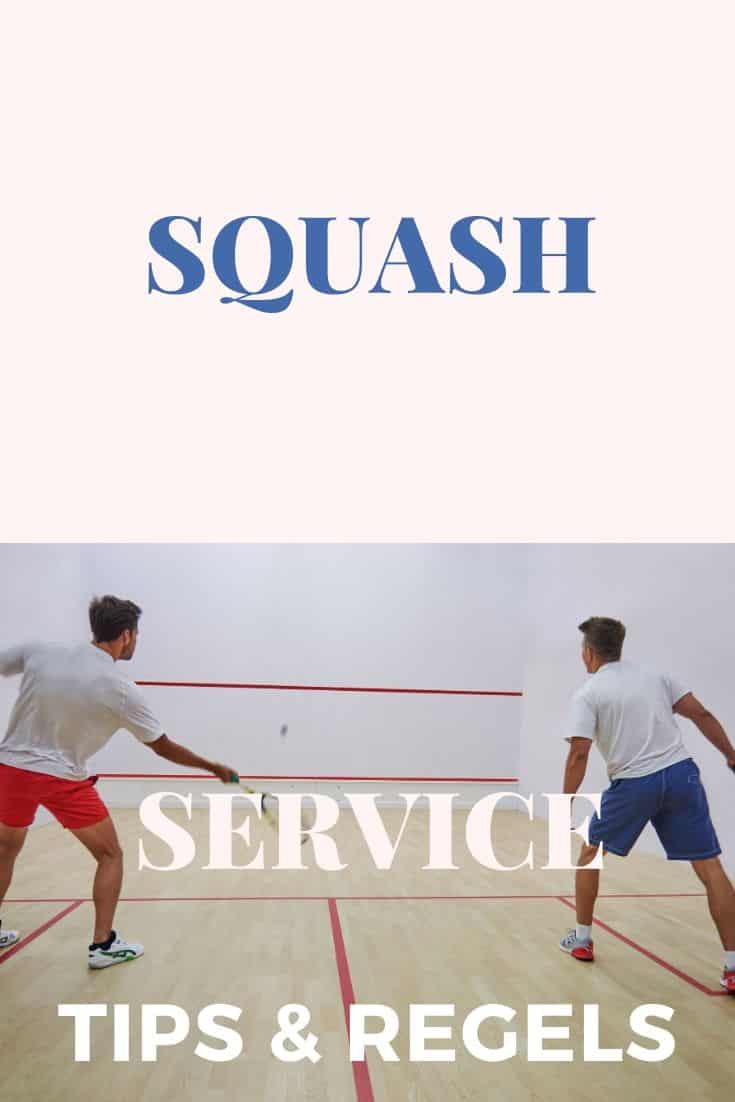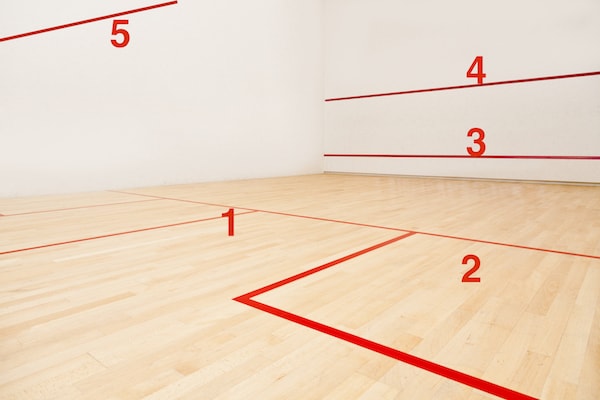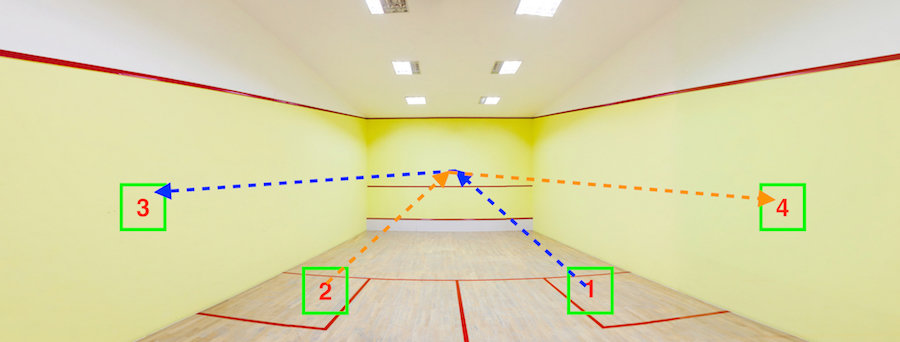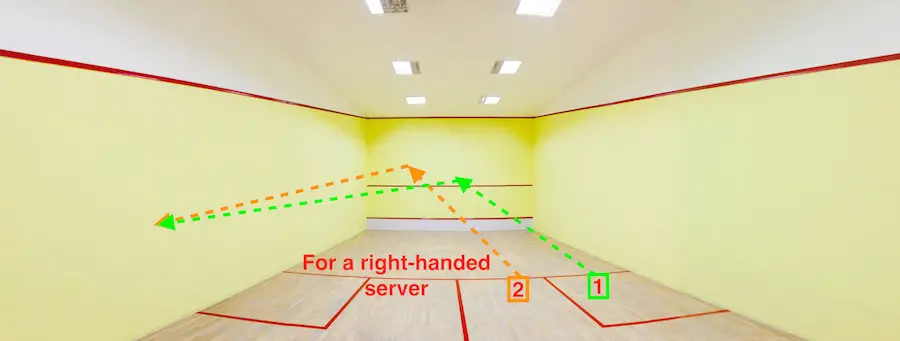I enjoy writing these articles for my readers, you guys. I don't accept payment for writing reviews, my opinion on products is my own, but if you find my recommendations helpful and you end up buying something through one of the links I may be able to receive a commission on that. More information
The serve in squash is one of the most important shots you can take, as it is the first. However, because of the rules, the service is a bit of a neglected child.
And that's a shame! Because if you make it difficult for your opponent to make a good return during your serve, you immediately win a point.
Your first priority at the to serve in squash is to not let your opponent return the ball.
we have all squash service rules and tips collected here, so that you can get off to a good start without a doubt.

What we discuss in this comprehensive post:
Squash serve lines
Funnily enough, while the serving isn't considered very important in squash, most field lines are actually for serving!

(photo: squashempire.com)
Can you hit the red line in squash?
Note that in squash, in unlike in tennis, that if the ball touches the red line it is out, and therefore a point for the opponent.
Even if the squash ball only touches part of a line, it is already out. Likewise, your foot must not touch the service line while serving, or it is an immediate service foul.
As you can see above, we have:
- The “T”: Move towards the T after your serve, as it is where you want to be after your opponent returns the ball.
- Service Box: You have at least 1 foot in this box when you serve. If you keep 1 foot inside the box, and step 1 foot toward the “T” already, you will be better able to reach the “T” in 1 to 2 quick strides, which is ideal. When you or your opponent serve, you get to choose which side you serve from. Then you alternate serving to the left, the right, and the left again, etc. whenever there is a need to serve again after a point.
- The tin or net of the court: This does not apply to serve, but this is the lower limit to which the ball may hit the wall.
- Service “Out” Line: You must hit the ball above this line on your serve. Why? This ensures that the ball is brought into play reasonably and it does not always lead to a point immediately. This is also why service is not very important in squash.
- Out line: This rule applies to services as well as all shots during the rallies. All shots on or above the line are out.
Nick Taylor explains everything it takes to make a good serve here:
Should you serve from the left or right side in squash?
When a squash match starts, whoever wins the racket spin or coin toss decides whether to serve from the right or left side.
You can also choose again from which side you want to serve from the moment you win the service from your opponent. You then have to switch sides if you win consecutive points, which means you can't serve from the same side every time.
For example:
- Your opponent wins the toss at the start of the match and chooses to serve on the right
- He/she wins the next 2 points and serves left first, then right again
- You win the 3rd point and now get the chance to decide which serve to start from, left or right
- You choose the right side
- You win the next point and then serve from the left
- Your opponent wins the next point, and gets to choose again from which side he wants to serve
Also read: why do the squash balls have colored dots and what do they mean?
Which side is best served from?
This depends on whether your opponent is right-handed or left-handed. You always want to serve on your opponent's backhand, as it is most likely their weaker shot.
Since most players are right-handed starting out, it's almost always a good idea to serve from the right side, on their backhand.
What are you aiming for with your service?
Now that you know the lines and rules on the squash court, we can work on where exactly to hit the ideal serve.
As you will understand we want to make it as difficult as possible for our opponent to hit the ball with a good shot.
To do this, there are a few spots to aim for on the wall, as well as places to position your feet.

(photo: squashempire.com)
- Place your foot in this corner of the service box when serving from the right side of the court. Your other foot will be outward toward the “T”.
- Similarly, you have your foot in corner 2 on a serve from the left side of the court.
- Your right side service should contact the left wall here. Why? This is where your opponent will most likely try to hit the ball, and it's high enough that your opponent has to reach above his power for a volley, which is harder than hitting at waist level. The higher the better, without hitting the top line of course! Letting the ball hit the wall at that point makes it hard for your opponent to scrape the ball off the wall. They either have the option to hit the ball just before or just after the wall contact. This makes for difficult timing, and a more likely weak return!
- Similarly, your left serve should make contact with the right wall here, making it as hard as possible for your opponent.
Should the ball bounce when serving in squash?
The ball does not have to bounce on a squash serve. You must first hit the ball against the back wall without touching the ground first, then your opponent may also return the ball without it having bounced.
When bouncing after the ball has hit the back wall, the ball must bounce into the opponent's box.
Always had the idea that squash is an expensive sport? Read about all costs here.
Do you get a second serve in squash?
Only one service attempt is allowed in squash. There is no second serve like in tennis. Your opponent has the option to volley and return your serve before it hits the ground. After hitting the front wall first, the ball may hit any other number of walls before landing on the opponent's court.
Types of Squash Serves
serve underhand
This is the most common service in squash, and should be used the most. Why?
Taking into account underhand or waist level, you can get the ball high enough on the sidewall, at a height that your opponent will find difficult to hit well.
Again, the higher the better, without crossing the out line.
It is also easier to maintain precision, control and accuracy with private service. It's a delicate shot that's easier to control than an overhand serve.
Can you serve overhand in squash?
Many people will have this question because underhand serve is the most common.
But just like an overhand serve at tennis you may use an overhand serve to make contact with the ball above your head or at head/shoulder level.
You can usually give this more speed, which can put some pressure on your opponent. However, most non-beginners will have no problem returning this service.
Usually, your opponent can bounce this serve, off the side and back wall, and you'll have a simple ball to return. Higher speed also means less accuracy in your service.
Furthermore, the squash ball also has a downward direction instead of an upward direction, which means that your opponent can bounce the ball first or hit it around the hip.
These are much easier returns than a high volley.
For these reasons, it is only advisable to use overhand services as a surprising change from a more accurate underhand service.
For example, you can randomly serve overhand about 1 in 10 times to surprise your opponent.
Lobby Service
The lob serve is a variation of the underhand serve, in which the squash ball is hit high on the back wall with an upward line and makes quick contact with the side wall just below the outside line.
When executed correctly, your opponent will have to hit him with a difficult high volley.
With a steep downward direction after hitting the side wall, your opponent can't let this ball go past him or it will hit the back of the field.
That said, the lob serve is a very difficult shot to execute well.
To get the desired effect of a difficult return, don't hit your ball too hard or it won't take the desired direction to the back of the lane.
Instead, it will land towards the center of the field, giving your opponent a big advantage.
Also, performing the lobe service has a high chance of landing above the alignment on the sidewall.
In short, it is a risky shot that is mainly used by more experienced players, in an attempt to win easily after a serve, but even then only as a change from the underhand service to surprise.
It takes a lot of practice to get right, and often isn't worth the risk.
The only pro who seems to be using it is James Willstrop, and it doesn't seem like it gives him much of an advantage against experienced players as they can return that serve reasonably well too.
Back Hand Service
The backhand serve is the most common in squash, and should be used the most. Why?
Subject to underhand or waist height, you can get the ball high enough to hit the sidewall at a height that your opponent will struggle to hit well.
Again, the higher the better, without crossing the out line.
It's also easier to control your precision and accuracy when serving from backhand.
See the ball lanes in the image below:

(photo: squashempire.com)
- The green trajectory, from a right-handed forehand, bounces further off the sidewall and is easier for your opponent to return well.
- The orange trajectory, from a right-handed backhand, is almost parallel to the sidewall, giving your opponent less room to make a return. There is a higher chance your opponent will scrape the sidewall with his racket and a higher chance of a weak service return.
Because there must always be 1 foot in the service box, a right-handed player with a backhand serve from the correct box can direct the ball closer to the sidewall to his opponent.
Playing with your forehand from a correct position in the box means that the squash ball hits the sidewall at a greater angle, giving your opponent a lot more room to hit the ball.
Also read: if you have some money to spend, these are the squash rackets to consider
Service Return
Returning a good serve in squash is essential to turning the rally to your advantage, and preventing your opponent from easily taking a point from a weak return.
To make the best serve return in squash:
- Watch your opponent. This is to see what kind of service they are going to make
- Place yourself at least 1 racket + an arm's length away from the side wall, to give yourself room to hit the ball
- As your opponent serves, rotate your body so your chest is parallel to the sidewall, giving you room to pivot through your shot
- Attack a weak serve with a straight drop or other offensive shot. A good serve will force you to play a straight length or a crosscourt if you have the space.
- Trying to attack after a well-placed serve is risky, and you'll end up losing more points than you gain from these attempts.
Positioning for a return
The receiver's position is best to be slightly behind the service court and keep your racket + an arm's length away from the side wall.
General serving recommendations
For a right-handed player: hit from your backhand from the right service box and forehand serve underhand from the left service box.
For a left-handed player, hit a backhand serve from the left box and forehand serve from the right.
When serving, remember the following important points:
- Move one foot out of the service area toward the “T”. Keep the other foot in the box for your serve.
- Try to bring the squash ball into contact with the side wall exactly where your opponent is standing. Some players are further forward or further back, so you can hit your serve softer or harder based on this.
- Vary your underhand serve every now and then with an overhand or lob serve. This is optional and is only meant to surprise your opponent
Also read: what should I pay attention to when buying good squash shoes?


